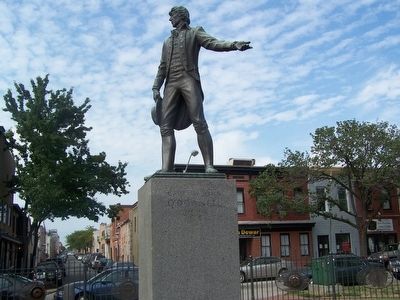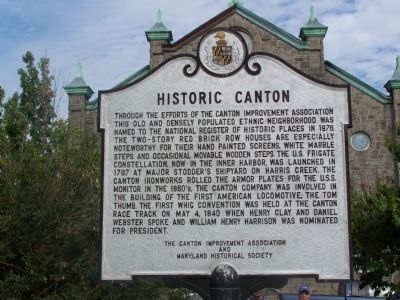Canton in Baltimore, Maryland — The American Northeast (Mid-Atlantic)
Historic Canton
Through the efforts of the Canton Improvement Association this old and densely populated ethnic neighborhood was named to the National Register of Historic Places in 1978. The two-story red brick row houses are especially noteworthy for their hand painted screens, white marble steps and occasional movable wooden steps. The U.S. Frigate Constellation, now in the Inner Harbor was launched in 1797 at Major Stodder’s shipyard on Harris Creek. The Canton Ironworks rolled the armor plates for the U.S.S. Monitor in the 1860’s. The Canton Company was involved in the building of the first American locomotive, The Tom Thumb. The first Whig Convention was held at the Canton Race Track on May 4, 1840 when Henry Clay and Daniel Webster spoke and William Henry Harrison was nominated for president.
Erected by The Canton Improvement Association and Maryland Historical Society.
Topics and series. This historical marker is listed in these topic lists: Architecture • Industry & Commerce • Railroads & Streetcars • Waterways & Vessels. In addition, it is included in the Former U.S. Presidents: #09 William Henry Harrison series list. A significant historical month for this entry is May 1770.
Location. 39° 16.814′ N, 76° 34.45′ W. Marker is in Baltimore , Maryland. It is in Canton. Marker is at the intersection of O’Donnell Street and Potomac Street, in the median on O’Donnell Street. Touch for map. Marker is in this post office area: Baltimore MD 21224, United States of America. Touch for directions.
Other nearby markers. At least 8 other markers are within walking distance of this marker. The Canton Library (about 400 feet away, measured in a direct line); a different marker also named Historic Canton (approx. 0.2 miles away); The Railroad to Freedom (approx. 0.2 miles away); Frederick Douglass' Escape from Slavery (approx. 0.2 miles away); Korean War Memorial (approx. 0.2 miles away); a different marker also named Historic Canton (approx. ¼ mile away); a different marker also named Historic Canton (approx. ¼ mile away); a different marker also named Historic Canton (approx. ¼ mile away). Touch for a list and map of all markers in Baltimore.
More about this marker. The statue, pedestal and a plaque were removed in April, 2021. The Canton Community Association and the chair of the Canton Anti-Racism Alliance said the statue did not represent the values of the community they want to build. In 1786, O'Donnell founded Canton as a plantation where he owned slaves. The statue was moved to an undisclosed location.
Related marker. Click here for another marker that is related to this marker. John O’Donell’s gravesite is commemorated by this marker.
Also see . . .

Photographed By William Pfingsten, September 9, 2007
2. Statue of Captain John O'Donnell (now removed).
1979 bronze by Tylden Streett (1922– ) is approx. 8 feet high on a six foot granite base.
From the Smithsonian Institution Research Information System: “John O’Donnell, a native of Limerick, Ireland, arrived in Baltimore in 1785. Already a wealthy merchant, he purchased several tracts of waterfront land east of Fells Point and named his property after Canton, China, from where he imported many of his goods. He represented the city of Baltimore in the State legislature, gained a repuation as an orator, and became known as the ‘Father of the Potomac Canal.’ Although a Colonel in the Militia, he was known as Captain O’Donnell because of the many ships he owned and sailed. During his career, he was, among other things, a clerk, an accountant, a ship owner, a wine maker, a politician, an adventurer, and was once captured by Arabs and sold into slavery. He held a position in the East India Company. At the age of 56, he was one of the wealthiest men in America.”
From the Smithsonian Institution Research Information System: “John O’Donnell, a native of Limerick, Ireland, arrived in Baltimore in 1785. Already a wealthy merchant, he purchased several tracts of waterfront land east of Fells Point and named his property after Canton, China, from where he imported many of his goods. He represented the city of Baltimore in the State legislature, gained a repuation as an orator, and became known as the ‘Father of the Potomac Canal.’ Although a Colonel in the Militia, he was known as Captain O’Donnell because of the many ships he owned and sailed. During his career, he was, among other things, a clerk, an accountant, a ship owner, a wine maker, a politician, an adventurer, and was once captured by Arabs and sold into slavery. He held a position in the East India Company. At the age of 56, he was one of the wealthiest men in America.”
1. Canton, Baltimore. Wikipedia entry (Submitted on December 17, 2023, by Larry Gertner of New York, New York.)
2. Canton Historic District. Trust for Architectural Easements website entry (Submitted on December 17, 2023, by Larry Gertner of New York, New York.)
Credits. This page was last revised on December 17, 2023. It was originally submitted on September 10, 2007, by Bill Pfingsten of Bel Air, Maryland. This page has been viewed 2,637 times since then and 34 times this year. Last updated on October 23, 2021, by Jordan Butler of New Windsor, Maryland, USA. Photos: 1, 2. submitted on September 10, 2007, by Bill Pfingsten of Bel Air, Maryland. • Mark Hilton was the editor who published this page.
